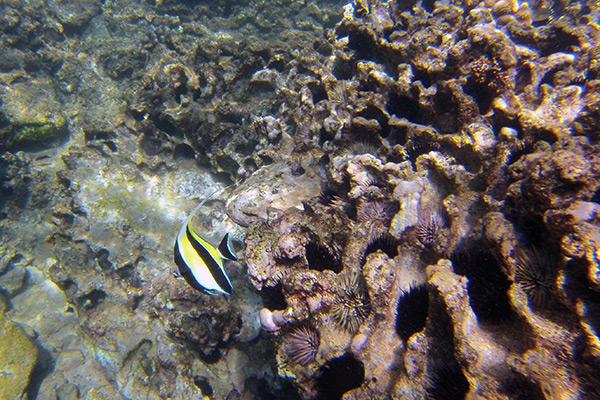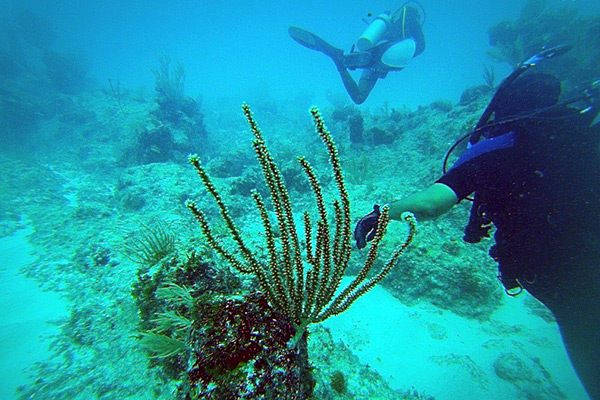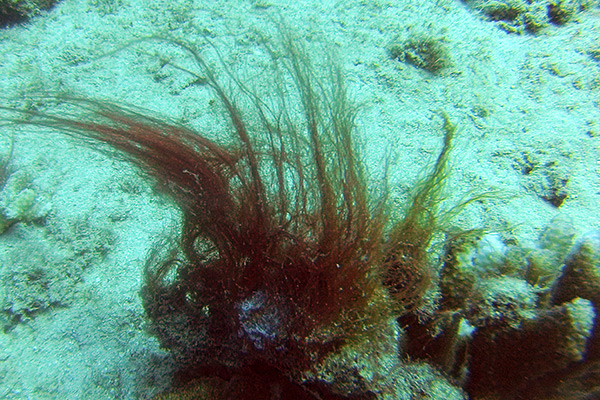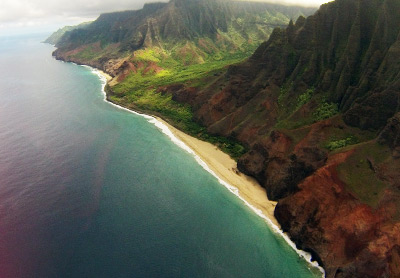I have been lucky in my life to have had the opportunity to dive in some of the prettiest and most diverse underwater habitats on earth. Without exception, the nicest dive sites are far from civilization, which stands to reason. But today I want to talk about the places that are in trouble biologically speaking.
The outer Hawaiian Islands
Last year, I went to some of the outer Hawaiian Islands for a nice vacation and, of course, to dive. My wife and I went to Hawaii on our wedding anniversary 44 years ago, and I dove then too, so I had an opportunity to assess the place decades later. The diving then was good, plenty of varied life with a smattering of sharks. This time, I was very disappointed. The amount of life was dismal with no large fish and virtually no sharks.
The “reefs” (what there was of them) were covered in algae, as there were very few herbivores such as the large schools of tangs I witnessed the first time I was there. Urchins are the predominant vegetarians there now, and Moorish idols are everywhere. They are adapted to eating sponges, algae, and whatever is in the “mulm” growth that covers the rocks.

This time I only did two dives there, but they were on the outer islands, not Oahu. But even on two dives I should have seen at least one crab or lobster. What I did see were plenty of crown-of-thorns starfish, which live by eating corals. They are over a foot across and can kill and eat a large coral very quickly. It’s very difficult to kill them because if you cut them up, they just grow from the pieces, so you have to remove them from the water, put them on a street, and have a school bus run them over, twice.
Corals there were few and far between, and I only saw small heads. All of them had algae growing on them.
Hawaii, like all seaside areas, has its share of invasive species. And not just fish. Since 1950, 19 invasive species of macroalgae have appeared in Oahu alone. These algae aren’t limited by the natural predators that would eat them in their home waters, so they cover and kill corals. This invasion is hard to stop, as much of it comes from the bilge water of ships.
I did see plenty of turtles, which I like, but the large number of turtles is proof that most of the large sharks that prey on them are gone.

On to the Dominican Republic
Last week, I went to the Dominican Republic, where I also did two dives. They were not very far from shore and not very deep, but the “reefs” there are in worse shape. As a matter of fact, most of the sessile invertebrate life consists of gorgonians and sea fans with a very small smattering of small brain corals and almost no fish.
Commercial fishing is down 60% in the last ten years due to overfishing and other factors. The visibility for a Caribbean island was also, in my opinion, very bad. I’m sure deeper waters farther from civilization would be a lot better, but I am also sure that 100 years ago both Hawaii and the Dominican Republic would have had reefs growing right up to the beach.

What (or who) is the problem?
The Dominican Republic gets more tourists (4 million a year) than any other Caribbean island, and the island isn’t that big. Unfortunately, we humans are the reason for the decline of the reefs. We like to blame global warming, rap music, and Brian Williams, but the problem is us, myself included. I like to go to tropical locations and stay at a resort by the beach with manicured grounds, pools, Jacuzzis, and unlimited food, but these things are not conducive to a healthy reef.
To build a tropical resort, they first destroy the mangroves and push away the rocks, bamboo, trees, bushes, dunes, and anything else that detracts from the use of the sandy beach that many tourists want. Then we launch our ski and scuba boats, snorkel, parasail, and smear oil and mosquito repellent all over ourselves. Of course, supermodels get their photos taken holding starfish (lucky starfish!).
All the stuff we discard on an island stays there, as the locals have little money to haul it away. It gets dumped in a hole someplace away from tourists where it gradually degrades and, with the rains, seeps back into the sea. The pools and fountains filled with chlorinated water get emptied regularly so they can be kept pristine. That water also goes back into the sea.
Enter erosion
But the worst killer of corals is erosion. Before people were there, the beach was covered in bushes, trees, and sometimes mangroves. Those bushes and trees kept the mud from running into the sea and covering corals. Now Islands are instead covered in asphalt so the rain can’t soak into the ground. The water runs off the roads and carries all the products of civilization, along with the sand, into the sea where it smothers corals. The dirt is also full of organics that cloud the water, blocking sunlight and growing algae.
A few years ago, I dove in Saint Lucia a couple of days after a big storm. The water was full of particles, and the corals, even hundreds of yards off shore, were covered in detritus. There were also large sea fans high up the side of the mountain because the shore was bare sand in front of a resort.
Corals grow high over the seafloor and calm wave action as they reach for sunlight, thus protecting the beach from erosion. So, after the corals are killed, beach erosion occurs up to 100 percent faster. That sand is then replaced by sand that is dredged offshore, put on a large tanker anchored in the bay, and pumped back onto the beach so we can stick an umbrella in it next to our lounge chair and call the waiter to bring us a pina colada.
On poorer islands, people fish using drag nets, which, besides taking all the sea life, kills corals and disrupts fish eggs that are laid under the corals.
Missing mangroves
Mangroves are an important site for small and spawning fish. When they are dug up, the fish leave and the beach is left to erode. Mangroves are the best protection for islands as very little can get through them. I recently explored mangrove islands in Florida and was amazed how tough it is to try to get through one. Going even a few yards into them is sometimes impossible.
Hope ahead!
But there is hope. In all those places, steps are being taken to limit the effects of humans on marine sanctuaries. Laws are being enforced to curtail poaching of fish and corals in protected areas, and construction techniques are being implemented to lessen the impact of civilization. The people in these places are starting to realize that tourism is a better money maker than fishing and that people do not want to go to a place where the sea is dead, as many people flock to these places to see and experience this life.
What diving has taught me about aquarium keeping
Diving all these years has taught me a thing or two about aquarium keeping besides the obvious things, like what the fish are eating. For instance, it has taught me that algae grows everywhere and the reason we don’t see it on a healthy reef is that the herbivores eat it before it gets long enough to notice. We cannot and should not try to eliminate it in our aquariums, as it is a healthy occurrence and not a harbinger of doom.
Note: Also read what Jeff has learned about aquarium keeping from being a scuba diver.
In a tank, we will never be able to control algae with fish because most fish poop inside the tank and the nutrients go right back into the water to grow more algae. We also can’t plant mangrove forests in most tanks to suck up the nitrates. What we can do is make friends with the algae, force it to grow where we can control it, and then remove it along with its nutrients. That is the purpose of an algae scrubber.

Another thing I learned firsthand from diving is that SPS corals won’t grow in turbid water while soft corals, such as gorgonians and sea fans, will thrive there but won’t live in pristine water. Also, these creatures require plenty of food and currents. We have to take these things into consideration as we purchase livestock for our tanks.
My tank is old and has plenty of nutrients, so gorgonians and LPS corals are perfect for my reef. In Tahiti, on the other hand, the water is about as clean as it is going to get, since that group of islands is thousands of miles from the nearest hotdog stand. SPS corals are the norm there, and there is little space that is not covered in them.



